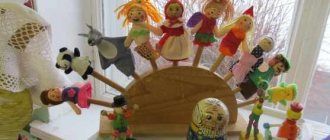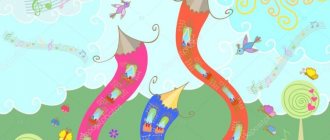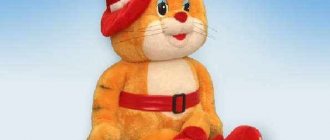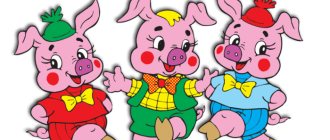Physical education and speech therapy entertainment based on the fairy tale “TEREMOK” in the second junior group
Physical education and speech therapy entertainment based on the Russian folk tale “Teremok”
in the 2nd junior group
Prepared and conducted by: teacher - speech therapist,
Instructor
in physical education
Goal: development of creative imagination, satisfy the natural need of children for communication and movement Objectives: Wellness: - To introduce children to a healthy lifestyle through physical activity: to form a positive attitude towards sports games and exercises Educational: - To form motor skills in children to strengthen them health - train your memory by remembering a fairy tale - strengthen the ability to stick an applique - enrich your vocabulary using nouns and adjectives. Educational: - cultivate friendly relationships between children; the desire to provide help to those who need it, to teach the ability to convey the actions and movements of fairy tale characters, to create a positive emotional mood. Equipment: small and large cubes - 10 pcs. everyone; small and large hoops - 2 pieces; gymnastic arch - 2 pieces; house "Teremok" soft modules, toys (mouse, frog, bunny, fox, wolf, bear). Preliminary work: - reading the fairy tale "Teremok" - conversation about the heroes of the fairy tale - coloring the heroes of the fairy tale Educational areas: - cognitive development - physical development - artistic and aesthetic development - social and communicative development Progress of physical education: Children enter the gym to the sounds of nature. Instructor: Oh, guys, look, something happened here. The house is destroyed and the animals are on the street. Let's ask, maybe you need help? Speech therapist: Guys, listen to what happened here. There was a hut in the forest, A fox, a frog, A mouse, a hare, a gray wolf lived in it - They know a lot about strong friendship. So the bear climbed up to them, and their house immediately broke down. (M. Blinnikova) Guys, what was the name of the house where all these heroes lived together? Children: Teremok Speech therapist: Guys, the animals’ house has collapsed, let’s help them build a new tower. We will remember the fairy tale and help the heroes. Guys, who was the first to live in the tower? (we help if necessary with leading questions, riddle-description) Children: Mouse! Speech therapist (takes a toy - a mouse): To help the mouse, I will turn you into mice too, and you will easily cope with everything. Turn around on one leg and turn into a mouse. What kind of mice are you? small, gray, fast. Instructor: Let's walk like mice (walking on tiptoes) and help the mouse put the grains into bags. Outdoor game “Each grain in its own bag”: small and large cubes and two hoops are laid out around the hall, children crawl under the arc, take one cube at a time, and run to carry the cube into a certain hoop (small ones into a small hoop, and large ones into a large hoop). After the game we put up one part of the tower. Speech therapist: Who came to the tower now? (we help if necessary with leading questions, riddle-description) Children: Frog Speech therapist (takes a toy - a frog): In order to help the frog, you also need to be turned into frogs. Spin around on one leg and turn into frogs. Instructor: Do frogs really like to play?
Outdoor game "Frogs".
In the middle of the hall, a cord is laid out in the shape of a “swamp” circle. The children are standing behind him. The instructor says: Here is a frog along the path, Jumping with its legs outstretched. Kva-kva, kva-kva-kva! Jumps with his legs stretched out. Children, turning one after another, jump on two legs, moving forward in a circle. At the end of the quatrain, the instructor claps his hands - scares the frogs; children jump into the “swamp” circle and squat down. The game is repeated 2-3 times. After completing the task, we install part of the house.
Speech therapist: Who came to the tower next? (we help if necessary with leading questions, riddle-description) Children: Hare Speech therapist (takes a toy - a hare): In order to help the bunny, you need to be transformed again. Spin around on one leg and turn into a bunny. Instructor: Guys, the bunny loves to dance! Dance “The bunnies danced in the clearing” (author A. Chugaikina).
After completing the task, we install part of the house. Speech therapist: Who came to the tower now? (we help if necessary with leading questions, riddle-description) Children: Fox Speech therapist (takes a toy - a fox): Spin on one leg and turn into a fox.
Speech therapist: I’ll give you more building material if you affectionately name all the heroes of the fairy tale. Children affectionately call the heroes of the fairy tale. After completing the task, we install part of the house. Speech therapist: Who came to the tower next? (we help if necessary with leading questions, riddle-description) Children: Wolf Speech therapist (takes a toy - a wolf): Spin around on one leg and turn into a wolf cub. Guys, what are wolves? gray, toothy. Instructor: And wolves love to play with bunnies. Let's play with you too? The outdoor game “Hares and the Wolf” is played. Children pretend to be hares, some of the children are wolves. On one side of the site for hares, houses or one common house are marked. The wolf is hiding on the opposite side in the “ravine”. In accordance with the text, the hares jump out of the houses, run around the site, then jump on two legs, then sit down and nibble grass, saying the words:
The hares gallop, hop, hop, hop. To the green meadow. They pinch the grass, eat it, listen quietly, Is there a wolf coming?
As soon as an adult says the word “wolf,” he jumps out of the ravine and runs after the hares, trying to catch (touch) them. The hares run away to their houses. The wolf takes the caught hares to his ravine. By agreement, after the wolf catches 2-3 birds with one stone, another child is chosen to play the role of the wolf. The game repeats itself.
After completing the task, we finish building the house. Speech therapist: Who came to the tower next? (we help if necessary with leading questions, riddle-description) Children: Bear Speech therapist (takes a toy - a bear): Spin around on one leg and turn into a bear cub. Guys, what kind of bears are they? big, brown, furry. Guys, let's put all the animals together so that they live together and have fun together.
Application “Animals in the mansion”
We consider the overall work, thank and treat the children on behalf of the animals.
Summary of the dramatization of the fairy tale Teremok in the 2nd junior group
Summary of the tetralization of a fairy tale in the second younger group
Purpose: - to promote the formation of children’s ability to reflect some game actions and imitate the actions of characters, convey simple emotional states of characters, using at least one means of expressiveness - facial expressions, gesture, movement (smiles, makes a scared face, shakes his head , waves his arms, etc.); — develop the ability to use various ways of obtaining information, the ability to ask questions; — to cultivate friendly relationships, goodwill, and a desire to help in younger preschoolers; help create a joyful emotional mood in children. Objectives: - encourage children to actively participate in theatrical play;
- develop the ability to coordinate actions with other children - the heroes of the fairy tale; - develop auditory attention, imagination, interest in performing arts. Materials and equipment: Hats - masks of the heroes of the fairy tale “Teremok”, decorations (teremok, wood), large building material for the tower. Progress of the lesson.
Educator: Today, guys, we will tell and show a familiar fairy tale together. Now I’ll show you a book with bright illustrations of familiar characters, and you tell me what the name of this fairy tale is? – show. Hidden on the pages of this book are a frog, a bunny, and a mouse. They live in the little mansion, the guys are waiting for you to visit. Children recognize and call it “Teremok”. Well done guys, that's right. Now guys, guess the riddles: Little white one, jump-jump through the forest, poke-poke across the snowball. Child: Hare! Educator: Good girl, Gelya! You will be a bunny (wear a mask). Next riddle: Jumps on the ground, swims on the water. Child: Frog... Educator: Yes, Timofey, you're right! You will be a frog (wear a mask). Next riddle: Who walks around angry and hungry in the cold winter. Child: Wolf, wolf... Educator: That's right, Nikita! (put on a mask). Next riddle: The red-haired cheat, cunning and dexterous, got into the barn and counted the chickens. Child: Fox. Educator: Veronica guessed right (put on a mask). Next riddle: In winter he sleeps, in summer he stirs up the hives. Child: Bear Teacher: Well done, Maxim! (put on a mask). And the last riddle: Who is hiding under the floor, afraid of cats? Child: Little mouse! Educator: Great, Nastya! You will be a bunny (wear a mask). And now, guys, get ready to listen to the fairy tale... There is a tower in the field, a tower. He is not short, not high, not tall. Here, across the field, across the field, a mouse is running (Nastya is heading towards the tower). She stopped at the door and knocked. Child: knocks, saying: pik-pik-pik, who lives in the mansion? Educator: There is no one in the mansion, no one answers the mouse. The mouse climbed into the little mansion and began to live there and sing songs. Educator: The frog is jumping across the field, across the field (Timofey jumps to the tower), stops at the door and screams. Child: Kva-kva-kva. Who lives in the little house? Child: I’m a little mouse, and who are you? Child: And I'm a frog. Educator: The frog jumped into the tower. They began to live, live, and sing songs. Here, across the field, across the field, a bunny runs, stops at the door and knocks (Gelya skips towards the tower). Child: Chuk-chuk-chuk, who lives in the little house? Educator: helps the children: I am a little mouse, I am a frog, and who are you? And I'm a runaway bunny! Teacher and children: Come live with us! And the bunny jumped into the tower. Here, across the field, across the field, a fox runs, stops at the door and knocks: “Who lives in the little house?” Children list who lives in the tower: mouse-norushka, frog-croak, bunny-runner. And who are you? Child: “I am a little fox-sister.” Educator: Come live with us. The four of them began to live together. There are already four of us living together. Brother Wolf is knocking on the house. Child: Who lives in the little house? Child: I am a gray barrel top - let me into the little house. Educator: He asks politely to let him in, there is nowhere for the poor to live. They also let the wolf in. And then a bear wandered in and began to roar. Child: Who lives in the little house? The children, with the help of the teacher, answer: come in, the bear, we have a big mansion, there’s enough room for all the animals. The bear breaks the tower, the animals run out of the tower and play catch with the bear, inviting the rest of the children. Educator: Well done to our kids, they deftly ran away from the bear. They told us a fairy tale, putting everything in its place. We stood together in a round dance, The people here are so friendly! Guys, look what happened to our tower! Children: The bear broke the tower... Educator: What should we do now? Children: We need to build a new tower. Educator: What kind of mansion will we build? Children: Big, bright, warm, beautiful…. Children build a tower from large cubes (pre-prepared large building material). After the construction of the tower, the teacher and the children talk about what kind of tower they got and how now the animals will live together in it.
We recommend watching:
Theatricalized - environmental games as one of the means of developing the ecological culture of preschool children. Abstract of educational activities in the middle group on the topic: “Getting to know the chicken family.” Theater in the 2nd junior group Master class. Free (joint) activity of the teacher with children
Similar articles:
Summary of theatrical activities for children of senior preschool age 5-7 years
Theatrical performance script for children of the preparatory group
Scenario of the festival of children's theatrical musical creativity for children of the preparatory group
An economic fairy tale for children of the preparatory group. Scenario




